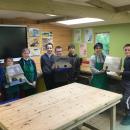What is a makerspace?
Makerspaces are creative spaces. These areas are designed to engage participants in hands-on activities that teach twenty-first-century skills. The emphasis in makerspaces is placed upon educating in STEAM (science, technology, engineering, art and mathematics) subjects as well as digital and information literacy.
Makerspaces are increasingly being looked to as a method for engaging learners in creative, higher-order problem-solving through hands-on design, construction, and iteration.
How does a makerspace benefit children?
Makerspaces benefit children by allowing them to:
- Be responsible for their own self-directed learning. Makerspaces allow children to explore topics that are of interest to them.
- Get creative. In the modern era, the ability to solve problems in an innovative way is critical to success. Makerspaces teach children to think creatively while also seeing the real-world impact of their work.
- Explore new ideas in a safe space. Because of the nature of the makerspace environment, children can feel more comfortable asking questions they may not have asked in the classroom. This exposes them to new ideas and ways to think.
- Learn how to fail and try again. Because of the focus on trial and error, makerspaces are an excellent place for children to test a hypothesis. If it doesn’t work, they have the freedom to question why and try again.
- Learn how to focus. Excessive sitting is proven to reduce attention in schools. Makerspaces allow children to focus on an idea or problem.
- Express themselves and collaborate. Expression and collaboration are critical skills to have in business. Makerspaces are an excellent way for children to learn how to share their ideas and get feedback.
- Develop a sense of self and a sense of community that empowers them to engage with and shape the designed dimension of their world.
How is the makerspace be used?
Our makerspace serves as a gathering point for tools, projects, mentors and expertise. A collection of tools does not define a makerspace. Rather, we define it by what it enables: making.
Our makerspace is a learning environment rich with possibilities. The children connect to work on real and personally meaningful projects, informed by helpful mentors and expertise, using new technologies and traditional tools.
The makerspace provides children with opportunities to use a number of tools such as saws, glue guns, drills, 3-D printers etc to undertake projects involving joinery, mechanical and electronic works.
Our curriculum is continuously developed to make specific links to the use of the makerspace and teachers work together to develop skills and expertise to ensure children are provided with opportunities to use this unique space.
The children are taught how to use tools correctly and how to keep themselves safe.
During activities the children also have the opportunity to develop leadership skills undertaking roles such as project managers etc.
How does the makerspace link to our vision?
Developing the Mind:
- Opportunities to develop leadership skills, confidence and resilience.
- A broad and balanced curriculum is proudly promoted.
- Creativity is nurtured across the curriculum.
- Learners are encouraged to flourish, shaping aspirations. Talents are developed in all areas of life.
Developing the Body:
- The unique talents of every child are embraced.
- Within a welcoming environment, personal progression is enabled.
- Learners are allowed to falter; to get things wrong and try again as they work out how to be in a relationship with themselves and others. They see modelled a community of compassion that makes this possible.
Developing the Spirit:
- Learners thrive in a shared society.
- Learners are supported to be the change they want to see in the world.
- Learners become agents of change.
- Learners are ambassadors who can make a positive contribution.
- Character development impacts on wider society enabling people to flourish together.











